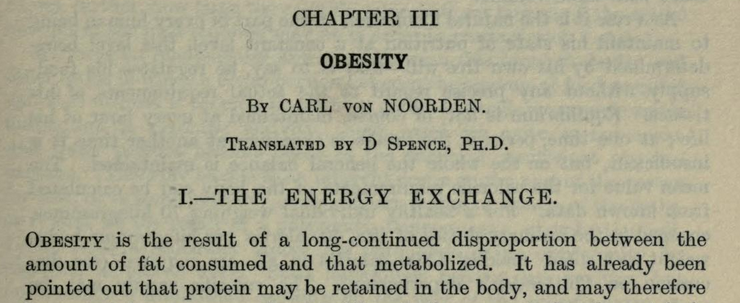— トピックス —
参考文献・書籍
2017.05.18
OBESITY(日本語訳)
『代謝と実践医療』 ー代謝の病理学ー
チャプターⅢ 『OBESITY(肥満)』(p693~695)

Ⅰ. エネルギー交換(The Energy Exchange)
肥満は、長年に渡る脂肪摂取量と代謝量の不均衡の結果である。
タンパク質は体の中に蓄えられるかもしれないということはすでに指摘されており、それゆえエネルギー源(太る原因)とみなされうるが、そのようなタンパク質の総量は通常少なく、食べ物のカロリー値が異常に大きくなるか、あるいはその他の理由でエネルギー細胞の成長が起こる場合にしか、タンパク質総量が増えることはない。この例外を除いて、細胞が直ちに必要としている食べ物以外の多くは、結果として貯蔵脂肪を増やすことになる。
実際、この食べ物の余剰は、しばしば全量が貯蔵され、タンパク質は変わらないことが多い。
それゆえ、好条件のもとでしか起こらないタンパク質の貯蔵について、下記の事実が明かになる:
体が必要とする以上の食べ物を摂取することは脂肪の蓄積につながり、その不均衡が一定期間以上続けば肥満につながる。
以上のことから、肥満は下記の結果であるといえる。
1.通常のエネルギー消費のもとでの食品摂取の増加。
2.通常の食品摂取における、エネルギー消費の減少。
ここで、筋肉活動の減少によるエネルギー消費減少と、酸化処理の勢いがなくなる体細胞の病気条件(例えば代謝の遅延など)の結果のエネルギー消費減少とを区別しなければならない。
3.二つの条件の混合。
これらの要素がどのように重なりあって肥満の様々な臨床形式を引き起こすのかというのは、特殊な病理学において扱われるべき問題である 。ここで我々が問題とするのは、原形質分解の減少の結果としての肥満、すなわち異常代謝の結果としての肥満が存在するか否かという点である。
1. 通常消費に関連した肥満
実際のエネルギー消費が通常範囲内に収まっている場合、肥満は長期に渡る食品摂取超過によるものであることは、臨床実験によって疑いの余地なく示されている。
摂取された食品の量や質は、上記のような肥満の重要な兆となる。このタイプの肥満を抱えるものはしばしば、少量で高いカロリーをもつ脂肪生成食品や炭水化物を好む。
一般的に言って、人間が自分の栄養状態を、自身の自由意志に基づいて選んだレベル、すなわち自分自身の細胞が実際に必要とするものとは無関係に選んだレベルで同じように保とうとするのは自然な傾向である。
当然のことながら、バランスはいつもいつも保たれているわけではない。
ある時には摂取過剰となり、またある時は摂取不足となるが、全体としての総合的なバランスは保たれているのである。
体が必要とするカロリー平均値は、よく知られたデータから計算できる。健康体で普通の生活をしている70kgの人物の必要カロリー平均値は40kカロリー/体重1kg/1日あたりの重量であり、全部で2,800kカロリーとなる(Chittenden実験の議論参照)。カロリー供給は下記の方法で構成される:

時には味の嗜好や食べ物の好み、料理の仕方や量に変化が生まれ、食べ物のカロリーが若干平均値を越えることがあると考えるのは合理的であろう。例えば食品に含まれるアルブミン、脂肪または炭水化物が少し増えるだけで、運動量が変わらなくてもカロリーは200も上がってしまう可能性がある。
この200kカロリーは食べ物としてはあまりにもわずかな量で、見た目や満腹感として気づくことは難しく、それゆえ当人は、明らかに太ってきたにもかかわらず、食品摂取は全く変えていないとしか言えないのである。
この200kカロリーは次の中に含まれる
ミルク1/3リットル
赤身200g
脂肪肉100g
ライ麦パン90g
ライトビール4/10リットル
食品摂取のカロリーがカロリー平均値を越えてしまうということは実際日常生活でよくあることであり、一日あたり200kカロリーというわずかな超過の実際の示すところは、次の計算で明かになる:
食品摂取の超過分はこの計算に影響しない極小量を除いてすべて脂肪として貯蔵され、200kカロリーはおよそ21.5グラムの脂肪に相当するので、1年間で7.85キロの脂肪を蓄えることになる。脂肪細胞は水を多く含むので、実際の体重増加は11kgまで増えるかもしれない。
この例のようなことは日常生活で頻繁に起こるもので、上記はこのような体の必要カロリーを超えるわずかな超過分によって徐々に肥満状態が進んでいくことを数字で表したものである。さらにこれは、カロリーがどれだけ高いか、そしてそれを含む食品がどれだけ少量のものかを表している。このタイプの肥満と、筋肉活動量が徐々に減少することで食品供給量とエネルギー使用量のバランスが崩れて起こる肥満とは、根本的には同じものである。
これらのような例は非常に多く、不十分な運動の結果として肥満を招くことになる。これはもしかすると楽を求める人間の本能的欲求や、心臓の欠陥や体肢の病気といった欠陥によるもの、あるいは閉じこもってほとんど活動しない無気力な気質のせいなのかもしれない。そのような人間は健康でなくなるが、それは細胞の酸化処理能力が落ちるからではない。細胞は仕事を与えられればそれぞれの役割を十分に果たすはずである。
もしも筋肉運動の減少が食品摂取の増加と合わさると、不幸なことに望まざる肥満のリスクは当然二倍になる。
このようにして生じた肥満は、様々な体の器官の機能、特に血管組織が損傷を受けるという意味で、間違いなく病気とみなされるべきである。しかしながら、このような人物の代謝機能は普通のままであるので、異常代謝とはみなされない。この場合、異常なのはライフタイルなのである(外因性肥満)。
臨床実験と実験結果はどちらも、このタイプの肥満が飛び抜けて多いことを示している。
それは一般的な認識であり、ここで問題となるのはエネルギー交換障害の結果としての肥満が生じるかどうかという点である。
2017.05.18
OBESITY(英文)
■こちらは、ノールデン氏の文書(英文)です。
<Metabolism and practical medicine>(代謝と実践医療)
THE PATHOLOGY OF METABOLISM(代謝の病理学)
CHAPTER Ⅲ OBESITY(肥満) By Carl von Noorden
Ⅰ. THE ENERGY EXCHANGE(エネルギー交換)
OBESITY is the result of a long-continued disproportion between the amount of fat consumed and that metabolized.
It has already been pointed out that protein may be retained in the body, and may therefore be regarded as a source of gain, although the amount of such protein is usually small, and only becomes large when the calorific value of the food-supply is enormously increased, or when, for other reasons, an energetic cell growth occurs.
With this exception, by far the greater part of that food which is not required for the immediate wants of the tissues goes to enrich the fat depots ; indeed, often the entire quantity of this excess food is thus deposited, the protein remaining practically the same [Pfliiger (1)].
Leaving from our consideration, therefore, the deposition of protein which only takes place under favourable conditions the following facts remain :
The ingestion of a quantity of food greater than that required by the body leads to an accumulation of fat, and to obesity should the disproportion be continued over a considerable period.
From this it follows that obesity may occur as the result of
1. An increased food-supply with normal energy expenditure.
2. A normal food-supply with diminished energy expenditure.
Here one must distinguish between expenditure of energy diminished on account of muscle inactivity and that diminished as the result of a diseased condition of the cells of the body, whereby the oxidation processes are carried out less energetically i.e., a slowing of metabolism.
3. A combination of both conditions.
The extent to which these factors are severally instrumental in causing the various clinical forms of obesity is a question to be dealt with in the special works on pathology [von Noorden (2)]. Here we have only to consider the question whether or not a form of obesity exists which is the result of a diminution in the energy of protoplasmic decomposition, which may therefore be regarded as the result of abnormal metabolism.
1. Obesity Associated with Normal Expenditure.
Clinical experience has shown beyond all doubt that when the amount of actual energy expenditure lies within the normal limits, obesity is due to a long-accustomed but excessive intake of food.
The amount of food consumed, and the nature of that food, afford valuable indications of obesity from such a cause.
Such obese individuals frequently prefer fat-forming or carbohydrate food in which a high calorific value is combined with small volume.
As a rule it is the natural inclination on the part of every human being to maintain his state of nutrition at a constant level, this level being determined by his own free will that is to say, he regulates his food- supply without any precise regard to the actual requirements of his tissues.
Equilibrium is not, of course, maintained at every hour of his life ; at one time, perhaps, the intake is excessive, at another time it is insufficient, but on the whole the general balance is maintained.
The mean value for the calorific requirements of the body can be calculated from known data. For a healthy individual weighing 70 kilogrammes, engaged in the ordinary duties of life, 40 calories per kilogramme body- weight per diem, making 2,800 calories in all, are required (see discussion on Chittenden's experiments). The calorific supply may be made up as follows :

It is reasonable to suppose that at certain times slight changes may occur in taste, or in choice of food, or in its preparation and quantity, whereby the calorific value of the food may be raised to slightly exceed the mean.
On a diet, for example, containing a little more albumin, fat, and carbohydrate, the calorific value may be increased by 200 while the individual continues to engage in his usual duties.
These 200 calories represent such a small amount of food that neither eyesight nor appetite afford any indication of it, and therefore the person can say to the best of his knowledge that his food-supply has not been altered, although he has obviously become corpulent.
The 200 calories in question are contained in
1/3 litre milk,
200 grammes lean meat,
100 grammes fat meat,
90 grammes rye-bread,
4/10 litre light beer.
Cases in actual life in which the mean calorific value of the food- supply is unknowingly exceeded occur very frequently, and the actual meaning of the small excess of 200 calories per diem may be illustrated by the following calculation :
The entire food excess, with the exception of a small fraction negligible in this calculation, is laid up in the fat depots, 200 calories corresponding to 21-5 grammes fat, so that a total fat accumulation of 7-85 kilogrammes may occur in one year. As the fatty tissues contain water, the increase in weight may be as much as 11 kilogrammes.
The example just cited is characteristic of what occurs very often in every-day life, and is intended to express numerically how, by an insignificant increase in the food over and above the amount actually required by the body, a state of obesity may gradually develop. It shows, further, how large the calorific value, and yet how small the actual amount of the food required may be in order to produce such a state.
There is no fundamental difference between this form of obesity and other forms in which a disproportion between the amount of food supplied and that utilized is brought about by a gradual though incomprehensible diminution in muscular activity.
Such cases are quite as numerous, and these persons become obese as the result of insufficient physical exercise.
This may be due to an inherent desire on the part of the person for ease, or to some infirmity, such as heart failure or disease of the limbs, or it may be the result of a phlegmatic temperament, whereby the individual leads a sedentary indoor life with little or no opportunity for engaging in active work.
Such individuals become less healthy, but not through a diminished capacity on the part of the cells to carry on their oxidation processes.
If the cells were permitted to work, then they would carry out their functions even as extravagantly as those of the normal individual.
If the disinclination for muscular exercise is combined with an increased indulgence in food which is, unfortunately, only too often the case then the danger of undesirable corpulency is, naturally, doubled.
There can be no doubt but that obesity so produced must be regarded as a disease, for the functions of the various organs of the body, in particular those of the vascular system, are damaged, and life may be thereby shortened. One cannot, however, regard this as disordered metabolism, for the metabolism of such obese persons is normal, and remains so ; it is the mode of living which is abnormal (exogenous obesity).
Clinical experience, as well as experimental results, show that this form of obesity is by far the most common. It is generally recognised as such, and the question only remains whether or not a form of obesity occurs which is the result of impaired energy exchange.
2016.08.20
人はなぜ太るのか?【ゲーリー・トーベス】/【岡田 正彦】
-
- 「人はなぜ太るのか?(そして、どうすればいいか)」ゲーリー・トーベス著
- 「人はなぜ太るのか?(肥満を科学する)」岡田正彦著
- 「人はなぜ太るのか?(そして、どうすればいいか)」ゲーリー・トーベス著

この2冊を読みましたので、その簡単な内容紹介と私の感想を書きたいと思います。
タイトルは似ていますが、中身は・・・というと対照的な内容でした。
1.「人はなぜ太るのか?」 【ゲーリー・トーベス著】(2013年)

【著者紹介】 Gary Taubes
『よいカロリー、悪いカロリー』の著者
カリフォルニア大学公衆衛生バークレー校で健康政策研究の研究員も務める。科学・薬学・健康に関する記事を雑誌サイエンス、アトランティック、ディスカバー、ニューヨークマガジンなどに執筆。
ハーバード、スタンフォード、コロンビア大学で学ぶ。
▽私はこの本に出合えたことに、心から感謝します。
著者が前作から10年以上費やしたと言われる通り、世界中の本やwebを探してもない内容がここにはあります。
私のブログと重なる点も多く、皆さんに紹介したいことが多数あったので、今後も引用させて頂くことになりそうです。
現在、広く普及した「私たちは消費するよりも多くのカロリーを摂取するから太る」(「入るカロリー/出るカロリー」説)という考え方がどのような歴史的背景の中で生まれ、反論する研究も数多くあったにもかかわらず、なぜ全世界に広く普及してしまったのか?

そして専門家が行ってきた、肥満治療(過食をやめさせること、運動をすること)で痩せない事実が多数あったにも関わらず、それが医学界では常識となってしまった経緯についても説明してあります。
著者自身は、肥満の原因はカロリーではなく『糖質(炭水化物)』であると考えておられ、糖質(炭水化物)制限を推進されています。
しかしその方法のみに固執せず、多方面から深く研究・考察されており、「読者に批判的に読んで欲しい」と言われるように、まだその研究が完璧でないことも示されています。
ともすれば、1世紀近くにわたり『肥満』の根本的な原因が解明されていないことに触れ、多くの肥満研究家のやってきた事が根本的に間違っているかもしれないという可能性まで示唆してあります。

(著書より引用)
科学の歴史は別の解釈を示している。
人々がこの仮説について1世紀以上考え、何十年も真偽を確認しようと試み、それでもなおそれが真実であると納得させるエビデンス(科学的根拠)が生み出せないとすれば、おそらくそれは真実ではない。(~略~)
これは科学の歴史において、一見、理屈に合っていると思われる多くの考えのうち、一度も成功しなかったものの1つである。そしてすべてを再考し、どうすれば体重を減らすことができるのかを見つけ出さなくてはならない。(引用以上)
2.「人はなぜ太るのか?(肥満を科学する)」 【岡田 正彦】(2006年)

【著者紹介】
新潟大学医学部卒業
同大学医学部教授、医学博士
米国学会誌などでの編集委員、学会誌『生体医工学』編集長など務める。
この本は、現在の医学の常識として分かっている範囲で、『肥満』についてわかりやすくまとめられていました。(肥満の測定方法、肥満にまつわる病気、痩せ方etc)
著者自身が、「多くのダイエット本とは一線を画し、学術論文と同じくらいに、間違いなく役に立つ情報をまとめた」と言われる通り、幅広い知識を得ることができ、読みやすい本でした。
内容は、今の常識がそうなっているように『カロリーの摂り過ぎ・食べ過ぎ』・『運動不足』が太るんだ、という考えに基づいて書かれています。もちろん、グリセミック指数や褐色脂肪細胞、肥満遺伝子、ホルモン(レプチン、インシュリン等)などのカロリー以外の原因についても幅広く説明してあります。
しかし、『人はなぜ太るのか?』という核心部分には触れていないと思いました。
脂質(脂肪)を食事で摂って、それが体脂肪になる過程は書いてあるが、ではなぜ私が太って、あの人は太らないのか(逆に、あの人が太って私は太れないのか)?という違いは説明されていないと思いました。

著者自身、「肥満には食事の影響(生活習慣)はもちろん、遺伝的な体質も大いに関係している。肥満は両者があいまって起こるものなのだ」と言われる通り、過食やカロリーで説明できないことは『遺伝的な体質だ』と言ってしまえば、誰も反論することはできない。しかし私が思うのは、カロリー神話を疑いもしない、そういう曖昧な考え方こそが間違った常識を根付かせているのだと思います。
